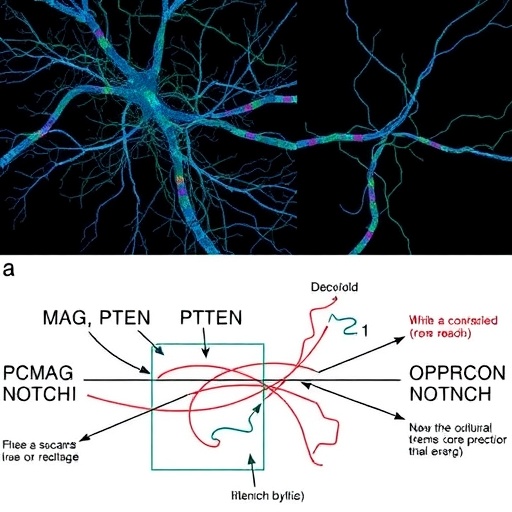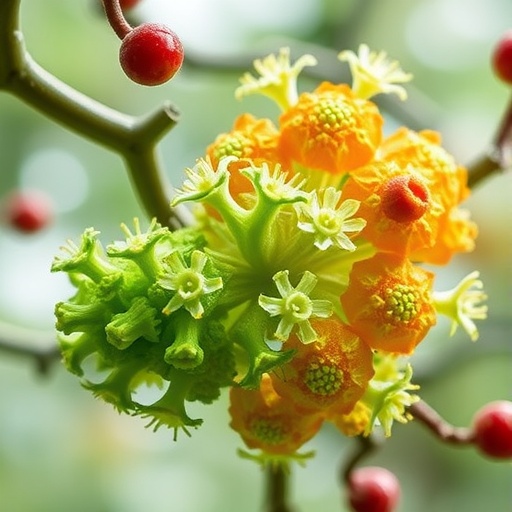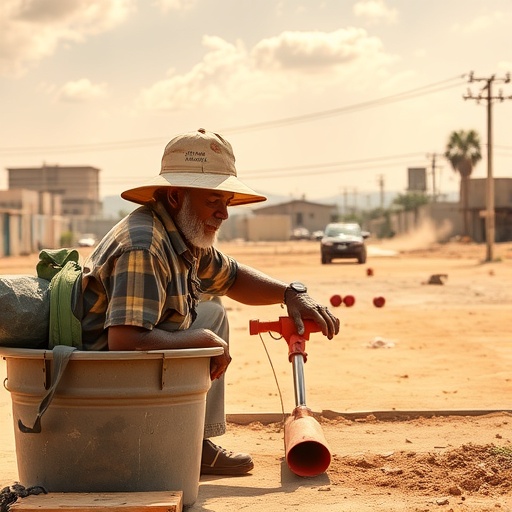In the burgeoning field of neurobiology, new research has emerged that unveils the intricate mechanisms behind axonal regeneration—a critical process for repairing neural connections after injury. The study, conducted by an innovative team of scientists including Salimi, Moeinafshar, and Rezvantalab, dives deep into the roles of specific molecular players: Myelin Associated Glycoprotein (MAG), Phosphatase and Tensin Homolog (PTEN), and NOTCH1. This exploration is not merely a cursory review but a comprehensive network analysis that integrates molecular dynamics simulations to elucidate the interactions among small interfering RNA (siRNA), pharmacological agents, and nanocarrier systems. Their findings may potentially alter therapeutic approaches in regenerative medicine significantly.
The regeneration of axons following neural injury represents a complex biological process, influenced by a plethora of factors at both the cellular and molecular levels. Within this ecological niche, MAG emerges as a pivotal molecule that inhibits axonal regrowth in the central nervous system. This inhibition poses a significant hurdle in recovery from neurological impairments, rendering the understanding of MAG’s pathways paramount for developing effective regenerative strategies. The study meticulously evaluates how MAG interactions with other cellular components can explain the failure of axons to regenerate successfully.
Further complicating the axonal regeneration puzzle is the presence of PTEN, a well-known tumor suppressor gene that has far-reaching implications beyond cancer. PTEN functions primarily as a phosphatase that modulates cellular signaling pathways, including those involved in axonal growth. In the context of neural injuries, PTEN’s regulatory capacity seems to halt the regenerative processes, making it a critical target for researchers seeking to promote recovery. The authors conducted a detailed analysis of the pathways guarded by PTEN, shedding light on potential therapeutic targets that could mitigate its inhibitory effects on axonal regeneration.
One cannot overlook the multifaceted role of NOTCH1, another significant player in this intricate web of neural growth. NOTCH signaling operates as a complex regulatory mechanism in many developmental processes, including neuronal differentiation and survival. In their study, Salimi and colleagues elucidated how NOTCH1 interacts with both MAG and PTEN, creating an intricate signaling network that influences the regenerative capabilities of injured neurons. Their findings position NOTCH1 not merely as a signaling molecule but as a potential therapeutic target that could be manipulated to enhance axonal regrowth.
The integration of network analysis with molecular dynamics simulations enriches this research, offering a dynamic view of the interactions among these proteins and their downstream effects. Through meticulous computational modeling, the researchers were able to simulate various scenarios involving siRNA molecules and pharmacological agents designed to either inhibit or promote the functions of MAG, PTEN, and NOTCH1. The results from these simulations provided unprecedented insights into how drug interactions can be optimized to enhance regenerative responses.
Considering the potential implications of this research, the study also delves into the use of nanocarriers for delivering therapeutic agents effectively. Exploring the intricacies of drug delivery systems, the authors evaluate how these nanocarriers can be engineered to cross the blood-brain barrier and provide targeted treatment to areas of neural injury. Understanding the pharmacokinetics and cellular uptake of these nanocarriers is crucial for translating laboratory findings into clinical applications.
As advances in target-specific drug delivery systems continue to evolve, the findings of Salimi and colleagues could play a significant role in designing next-generation therapeutics for neuroregeneration. The interdisciplinary approach that combines molecular biology, computational analysis, and nanotechnology embodies the potential for creating innovative solutions to previously intractable problems in neurobiology.
In conclusion, the investigation of MAG, PTEN, and NOTCH1 offers a promising roadmap for the future of neurological recovery. By elucidating the molecular underpinnings of axonal regeneration, this study opens new avenues for therapeutic intervention that could improve outcomes for individuals suffering from neurological injuries. As research continues to unfold in this area, the vision of restoring lost neural connections becomes increasingly attainable.
This research stands as a compelling argument for a transformative shift in how we approach neural regeneration, fostering hope that future breakthroughs will bring about tangible improvements in clinical practice. The complexities unraveled through this study highlight a critical need for ongoing interdisciplinary research, ensuring that the insights gained are effectively translated into real-world applications that improve patient outcomes.
With substantial technological advancements marking the landscape of neuroscience, studies like this remind us that the future of treating neural injuries is not just a distant dream but a burgeoning area of active exploration. The convergence of molecular dynamics, innovative drug design, and targeted nanocarrier systems heralds a new era in regenerative medicine where previously unattainable objectives in axonal repair may soon become achievable milestones.
In an era dominated by rapid advancements, the implications of understanding axonal regeneration extend beyond the lab and into our understanding of neurological health on a broad scale. Addressing the challenges posed by neural injuries through targeted research not only benefits those directly affected but contributes to the overarching narrative of improving health and wellbeing for all.
As researchers and healthcare providers continue to collaborate across disciplines, the quest for effective therapies will undoubtedly draw on the findings of studies like that conducted by Salimi and his team. The journey towards unraveling the complexities of the neuronal landscape is continuous, with every new discovery propelling the field forward, bringing us closer to effective treatments that were once thought to be the stuff of science fiction.
In sum, the future of neuroregenerative medicine looks promising, grounded in research that delves deep into the molecular interactions that govern nerve repair. The insights gleaned from this study could ultimately lead to powerful new strategies for facilitating recovery after neural injuries, heralding a brighter future for neurobiology and regenerative medicine alike.
Subject of Research: Axonal regeneration and its regulatory mechanisms involving MAG, PTEN, and NOTCH1.
Article Title: Unraveling the role of MAG, PTEN, and NOTCH1 in axonal regeneration: a network analysis and molecular dynamics study of siRNA/drugs/nanocarriers interactions.
Article References:
Salimi, A., Moeinafshar, A., Rezvantalab, S. et al. Unraveling the role of MAG, PTEN, and NOTCH1 in axonal regeneration: a network analysis and molecular dynamics study of siRNA/drugs/nanocarriers interactions.
J Transl Med 23, 1038 (2025). https://doi.org/10.1186/s12967-025-07042-9
Image Credits: AI Generated
DOI: 10.1186/s12967-025-07042-9
Keywords: axonal regeneration, MAG, PTEN, NOTCH1, siRNA, nanocarriers, molecular dynamics, drug delivery, neurobiology, regenerative medicine.
Tags: axonal regeneration mechanismscellular interactions in axonal regrowthchallenges in central nervous system regenerationMAG role in neural repairmolecular dynamics simulations in neuroscienceMyelin Associated GlycoproteinNOTCH1 signaling pathwaysPhosphatase and Tensin HomologPTEN in neurobiologyregenerative medicine advancementssiRNA and pharmacological agentstherapeutic approaches in neurological recovery





